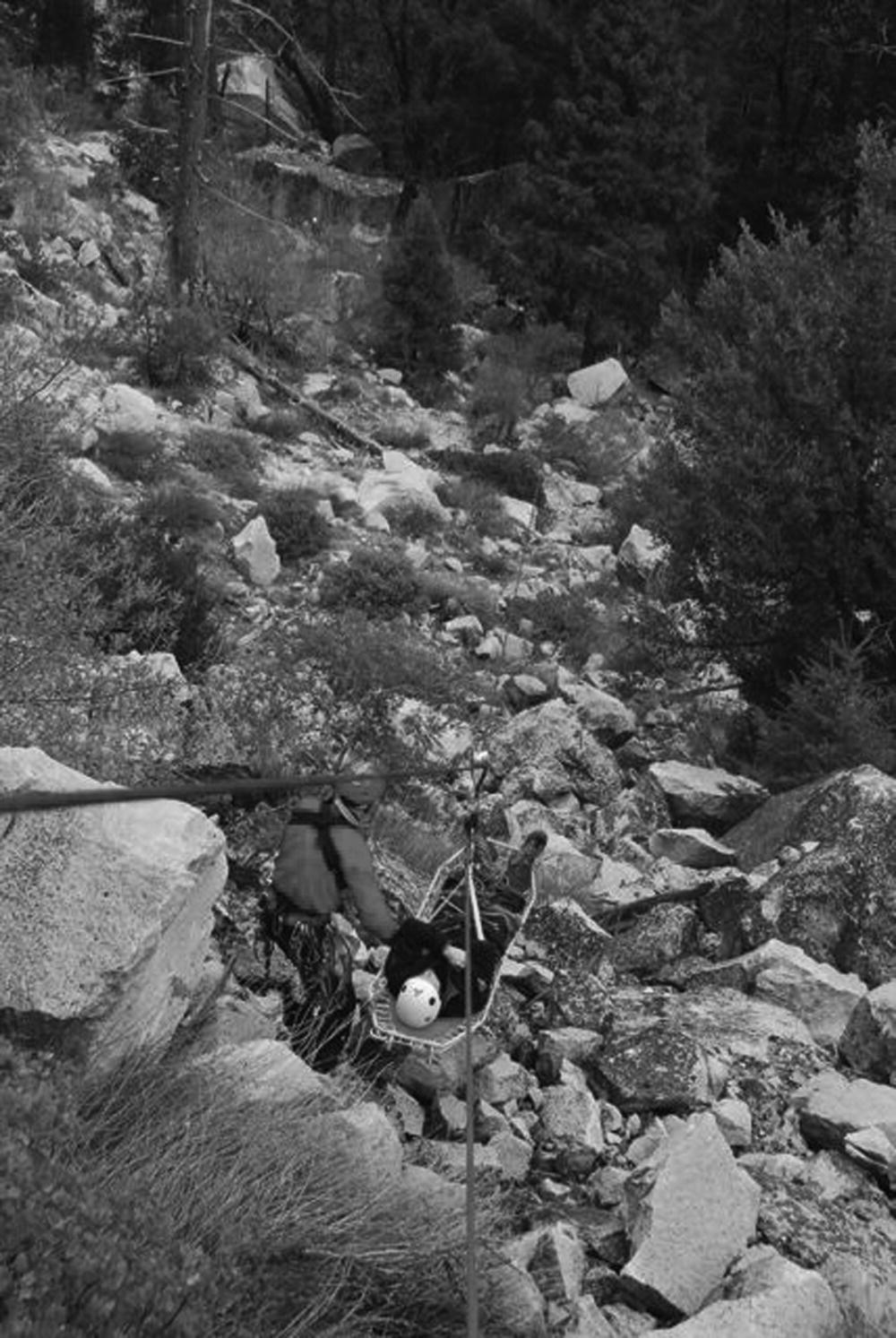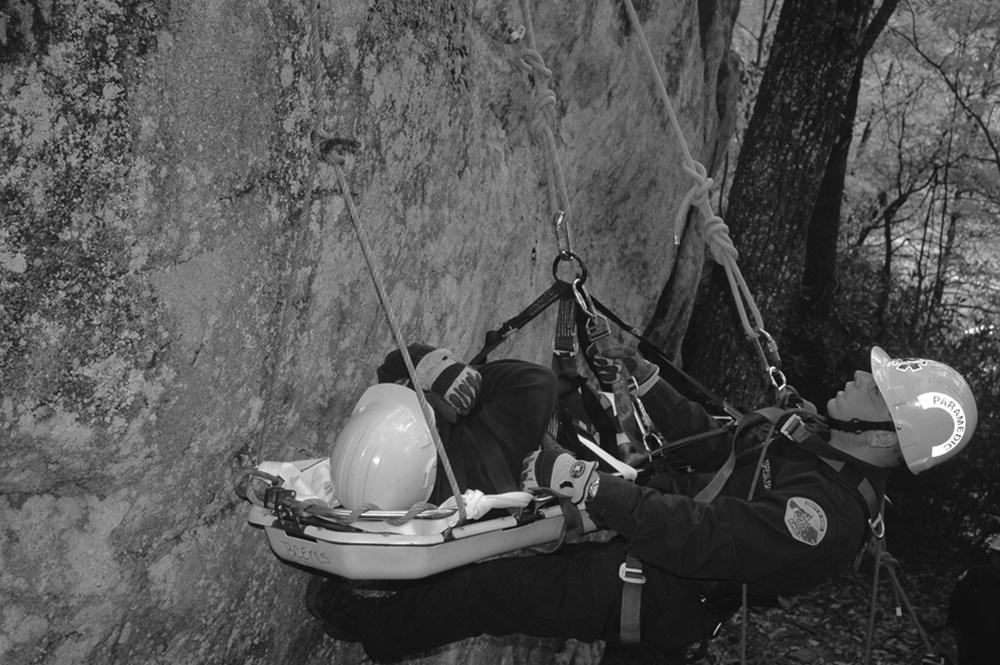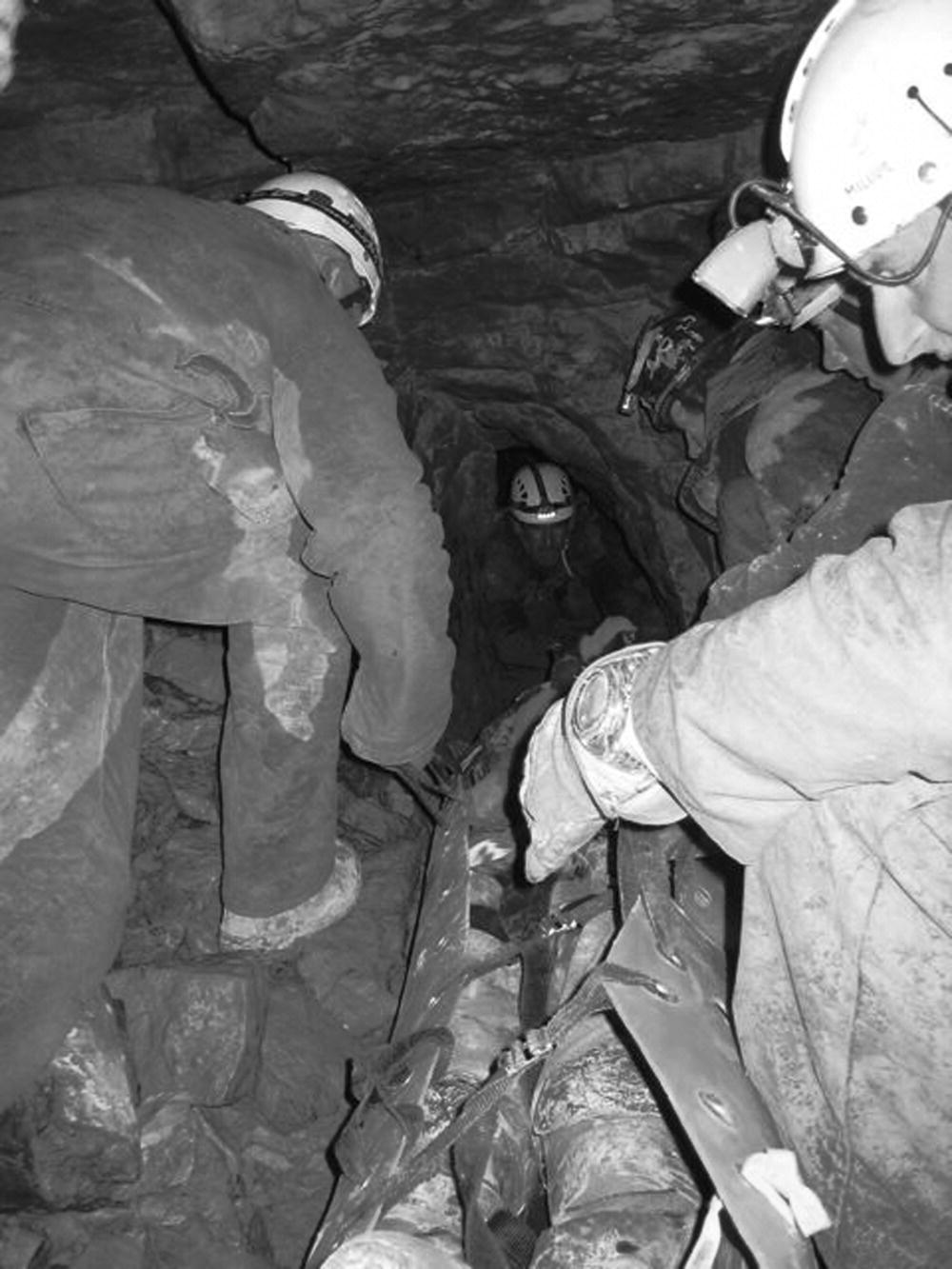Chapter 42 Seth C. Hawkins, Michael G. Millin, and William ”Will“ R. Smith Although there may be many ways to define wilderness, for the purposes of this chapter a wilderness setting includes any geographic area where typical medical resources are not adequate or available for the management of an injured or sick patient. Such settings may include deserts, mountains, rivers, oceans, space, caves, and other remote areas. In fact, urban areas during disasters can also be considered wilderness. The definition of wilderness environment is critical when discussing wilderness EMS (WEMS). WEMS providers should be authorized to follow operationally specific protocols, so the environment where those protocols becomes activated (the “wilderness” environment) must be defined. This is best accomplished via local or regional definition. Nearly every jurisdiction has the potential for wilderness medical care, whether due to environmental factors such as weather (limiting transport capability or complicating care), fixed geographic factors such as absence of roads or presence of parks or bodies of water, or potential for natural or manmade disasters resulting in the sudden need for austere medical care (New Orleans during Hurricane Katrina). Currently, a patchwork of protocols and levels of care exists across the country, as states and services grapple with how to anticipate and manage WEMS operations. There is not yet a national standard regarding what should be included in WEMS protocols and what an appropriate scope of practice is for this subspecialty of EMS physicians and providers; yet the idea that WEMS or austere medical care will never be needed for any given jurisdiction is naïve. Wilderness EMS providers typically have to personally carry all of the equipment that may be needed for the care of the patient as well as for their own safety and survival. WEMS physicians and providers require knowledge in personal survival in austere environments, search procedures, advanced wilderness medical care, and geographically specific extrication techniques, for the safety of their patients and themselves (Figures 42.1–42.3). Figure 42.1 Low-angle rescue with guiding line. Figure 42.2 High-angle rescue. Figure 42.3 Cave/confined space rescue. Although some authors define WEMS as any situation that involves a minimum 1–2-hour transport time, this definition does not encompass every WEMS experience. There may be situations that require specialized medical care prior to extrication or transport even if the area is near a roadside, such as a patient injured on the hill at a ski resort or a hiker in a large urban nature preserve. Due to the specialized skills required to manage these patients, the inability to get supplies to the patient easily, or a complex extrication without the aid of an ambulance, these situations must also be considered wilderness. It is important to understand that WEMS is substantially more complex than the application of traditional medical training in a wilderness environment, and the indiscriminate application of traditional care and standards often proves to be dangerous to patients and/or providers in a wilderness setting. Finally, it is important to draw a distinction between wilderness medicine and WEMS. Wilderness medicine is the broad field addressing the general care of patients in a remote, austere, or wilderness setting. Most often in popular dialogue and training paradigms, wilderness medicine assumes unexpected and opportunistic care. If, however, one specifically trains for a particular type of emergency medical response to a particular set of environmental challenges, joins a team that has specifically configured itself to provide medical care in a specific locality, and maintains a formal wilderness medicine certification to do so, then the care has entered the realm of WEMS. There are significant consequences to the differentiation of general wilderness medicine from specific wilderness EMS, not least of which are an expectation for increased professionalism, increased or more specific training for that particular environment, potentially increased equipment and familiarity with local emergency services, and by definition the probable establishment of a “duty to act” and different medicolegal expectations. One good illustration of this difference is in the different didactic preparations. With a few exceptions, general wilderness medicine teaching focuses on the ad hoc use of materials at hand, which may or may not have been originally purposed for medical care. There is a recognition that minimal medical equipment may be available since medical care is only one consideration among many for recreational or professional trips. WEMS retains some of this ad hoc and improvisational spirit, but since the entire purpose of the WEMS operation is rescue and medical care, choosing the most appropriate equipment specifically for medical care, and absolute familiarity with that equipment, becomes paramount. A more concrete example would be the response and medical care one would expect to be offered by a backcountry skier out for a day with basic wilderness medical training and a standard daypack who comes upon another skier with a broken leg and head injury in the remote backcountry. Then contrast the expectations of that caregiver with the expectations for the formal ski patrol unit that is dispatched to care for that same patient. This exemplifies the difference between general wilderness medicine and WEMS. Other terminology frameworks include programs with similar themes of austere and resource-deficient care (wilderness, disaster, tactical, military, remote) under an umbrella definition of “operational medicine.” So, for example, the National Association of EMS Physicians (NAEMSP) and the National Association of State EMS Officials (NAEMSO) identify all EMS providers operating in remote or austere conditions as being “operational,” specifically citing ski patrols, wilderness search and rescue teams, and fast or open water rescue teams as well as tactical EMS and urban search and rescue teams [1]. Other global terms for this category of care include “austere medicine” or “resource-deficient medicine.” Therefore, WEMS represents organized efforts wherein providers are assigned to specific geographic areas or missions with a specific duty to act. The purpose of WEMS is to provide care to an ill or injured patient in a wilderness setting while still recognizing that the providers are functioning within the defined health care system. It is the goal of WEMS to manage the patient in the field, extricate the patient, and transport to an acute care facility if needed. These goals are met with the concept that the patient should be receiving quality care with appropriate physician participation or oversight. The purpose of this chapter is to outline the structure of WEMS systems and define why and how health care systems that may need to provide wilderness care should consider developing or integrating formal WEMS programs. Wilderness medicine is in some ways the oldest of the medical disciplines. The first time one human attempted to help another, with or without rudimentary tools made from the surroundings, could be considered the beginning of wilderness medicine. However, as a formal subfield of modern medical practice, wilderness medicine is very new, and WEMS is in its infancy. The history of WEMS can be broadly divided into decades of evolution. Wilderness EMS is a field still defining itself, with new resources and programs appearing every year (please refer to the website for Box 42.1). Having generated data for many decades – longer than most WEMS systems have been in existence – the National Park Service has provided much of the best epidemiological information on WEMS operations. These data indicate that WEMS providers in national parks experience equal numbers of medical and traumatic EMS events (although more deaths are traumatic), and that the national incidence of EMS events is 46 per 1 million visitors [16]. However, this incidence may be misleading, as it includes many park areas that would not typically be considered wilderness. Other studies only focus on specific highly visited locations or specific wilderness activities. One useful study examined all incidents over a 3-year period in eight of the “most wilderness-type environment” national parks in California. This demonstrated an overall occurrence of 9.2 non-fatal events per 100,000 visits, with a mortality rate of 0.26 deaths per 100,000 visits. Men accounted for 78% of the deaths, with heart disease, drowning, and falls being the most common etiology [17]. Other ParkMedic data exemplify many of the different operational elements of WEMS, including non-transport rates of 77%, base hospital contact rates of 28%, and rates for ALS care of 10% (with 16% of these ALS patients not transported) [18]. These data amply demonstrate that WEMS providers have been working for decades in a very different operational environment than most traditional EMS authorities would recognize. As much as any other EMS subtype, WEMS argues for a redefinition of “prehospital” medicine” as “out-of-hospital” medicine, since the majority of patients in some WEMS systems receive all their care in the field and are not transported to hospitals. Despite growing academic and commercial attention, standardization of WEMS training and practice has not yet been achieved to the degree it has in other EMS specialties [19]. The Wilderness Medical Society (WMS) was founded in 1983 and serves as the professional society for wilderness medical practitioners. WEMS has been actively promoted by this organization and it has made some efforts towards WEMS standards. In 1991, the WMS proposed a model mechanism to develop a curriculum for wilderness prehospital emergency care (WPHEC) [20], with the intent of establishing a disciplinary standard for the WEMS field internationally [21]. However, this was not widely cited or implemented in subsequent commercial or academic courses, and the term “WPHEC” is no longer in widespread use. The WMS published minimum standards for wilderness first responder (WFR) certification in 1999 [22]. However, the maximum scope of practice may be the more controversial issue versus minimum curriculum standard. The WMS has also not yet defined the minimum curriculum or maximum scope of practice of wilderness EMTs (WEMT) or wilderness paramedics, which also is a potentially more controversial topic than WFRs. Among communities that professionally require and utilize wilderness medical training, such as outdoor experiential schools, colleges, guiding organizations, and others, there is no industry standard regarding wilderness first aid (WFA) training and certification of outdoor adventure/education leaders [23], and there is even controversy among experts surrounding the de facto standards that do exist for WFA [24]. In 2013, leaders of many commercial wilderness medicine schools published a consensus document establishing minimum standards and scope of practice for WFA. However, as noted by the authors themselves, the document exclusively addresses first aid standards, not EMS responder standards, and sets a minimum, where a maximum scope of practice may be the more salient question. However, this bodes well for future initiatives establishing standardized or consensus standards and scopes of practice for true EMS certifications [25]. In addition, the establishment of minimum standards for WFA and WFR also satisfies the requirements of EMS Education for the Future, which promotes the idea that there is a single level of minimum competency for each level of EMS credentialing, and that those labeled as EMS providers (presumably including WEMS providers) should be able to demonstrate ability at or above that level. Historically, NAEMSP Rural Affairs Committee has pursued important work on WEMS protocols and practice, establishing clinical guidelines for delayed or prolonged transport involving spine injury [26], dislocations [27], wound care [28], and cardiopulmonary arrest [29]. However, no new WEMS clinical position statements have appeared since 1993. In 2010, NAEMSP released a position statement on medical direction of operational EMS (including WEMS) [1]. This statement affirmed that WEMS programs and providers often require specialized skills, should function within and not outside the mainstream health care system, and should function with oversight from an appropriately trained, certified, and credentialed medical director. The position statement and an associated resource document [30] address medical director and system standardization, but neither specifically addresses certification or scope of practice standardization except to say that it is multifactorial and all applicable regulations must be followed. The American College of Emergency Physicians (ACEP) and the Society for Academic Emergency Medicine (SAEM) have formed wilderness medicine sections that have implicit interest in WEMS, especially as practiced by physicians, but no standardization positions have yet been formally taken by these groups. Wilderness EMS also accounts for many of the field health care providers and organizations who sometimes, despite meeting all apparent criteria for being EMS providers, operationally fall outside EMS supervisory processes such as medical oversight, standardization, and regulated scope of practice. These may include some ski patrols, lifeguards, SAR teams, and wilderness guides, among others. The National Ski Patrol’s OEC program, which is now commercially marketed as an all-seasons and all-environments wilderness medicine certification, has been particularly notable in this regard [4]. There is at least one instance of a state specifically defining OEC practitioners as first aid providers regardless of their scope of practice, thus potentially bypassing EMS regulatory oversight [31,32]. On the other hand, there is at least one instance of a state specifically declaring OEC as an EMS certification, thus explicitly putting it within the EMS oversight system [33]. The interface of all these WEMS agencies and teams with traditional EMS systems can be a subject of both local and national debate and negotiation [31,34,35]. The National Highway Traffic Safety Administration published EMS Education for the Future: A Systems Approach in 2000 [36] and The National EMS Scope of Practice Model in 2005 [37]. These were further refinements of a national standard for prehospital care promulgated by the 1996 EMS Agenda for the Future. The conceptual basis includes the application of the scope of practice of each of the four “levels” of EMS providers in all locations of the United States. Although these documents do not contain standards or sections addressing WEMS specifically, these concepts are still quite relevant to WEMS. Quite often in a wilderness event there may be a variety of levels of providers involved with the management of a patient. In addition, there may be times when a patient is managed by an EMS provider at the EMR or EMT level without the assistance of a provider at the level of AEMT or paramedic. While this suggests that scope of practice might need to be expanded in these circumstances, in a WEMS setting such expansion should be done only with appropriate indirect medical oversight well in advance of any anticipated need, and with the approval of the local and state EMS regulatory authority. According to the National EMS Scope of Practice Model, “… state regulations must be clear as to the extent to which the State’s EMS scope of practice applies to EMS personnel functioning in these non-traditional roles and settings. The employers of EMS personnel working in non-traditional roles and settings must also be aware to what extent the person’s State EMS license permits or prohibits such activities” [37]. This scope of practice issue is two-sided: the state needs to understand the requirements of the austere and wilderness environment, and the providers and provider organizations need to understand that the state has regulatory authority.
Care in the wilderness
Introduction



History
Current operations and epidemiology
Standardization
Scopes of practice
New scope of practice model
Levels of WEMS providers
Wilderness first aid (WFA)
Stay updated, free articles. Join our Telegram channel

Full access? Get Clinical Tree




